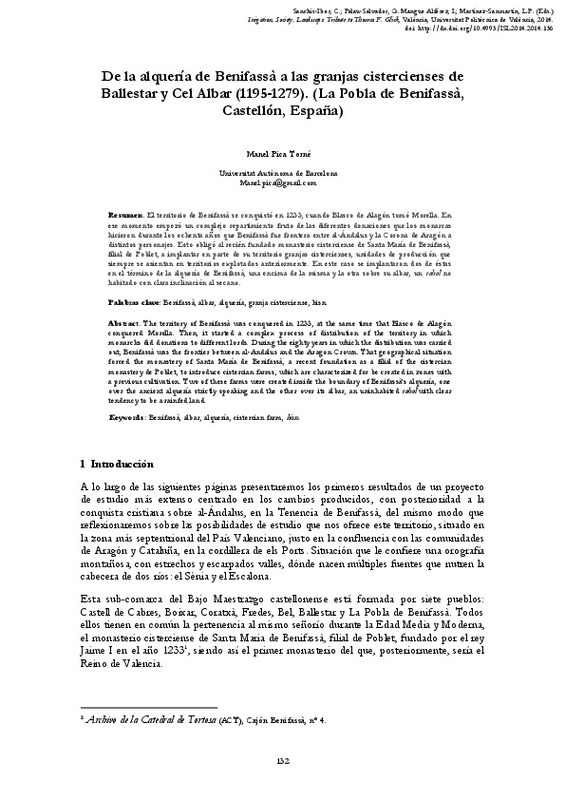JavaScript is disabled for your browser. Some features of this site may not work without it.
Buscar en RiuNet
Listar
Mi cuenta
Estadísticas
Ayuda RiuNet
Admin. UPV
De la alquería de Benifassà a las granjas cistercienses de Ballestar y Cel Albar (1195-1279). (La Pobla de Benifassà, Castellón, España)
Mostrar el registro sencillo del ítem
Ficheros en el ítem
| dc.contributor.author | Pica Torné, Manel
|
es_ES |
| dc.coverage.spatial | east=0.15633969999998953; north=40.656232; name=12599 Pobla de Benifassà, Castelló, Espanya | |
| dc.date.accessioned | 2017-09-27T06:12:48Z | |
| dc.date.available | 2017-09-27T06:12:48Z | |
| dc.date.issued | 2015-03-03 | |
| dc.identifier.isbn | 9788490482742 | |
| dc.identifier.uri | http://hdl.handle.net/10251/88013 | |
| dc.description.abstract | [EN] The territory of Benifassà was conquered in 1233, at the same time that Blasco de Alagón conquered Morella. Then, it started a complex process of distribution of the territory in which monarchs did donations to different lords. During the eighty years in which the distribution was carried out, Benifassà was the frontier between al-Andalus and the Aragon Crown. That geographical situation forced the monastery of Santa María de Benifassà, a recent foundation as a filial of the cistercian monastery de Poblet, to introduce cistercian farms, which are characterized for be created in zones with a previous cultivation. Two of these farms were created inside the boundary of Benifassà’s alquería, one over the ancient alquería strictly speaking and the other over its albar, an uninhabited rahal with clear tendency to be a rainfed land. | es_ES |
| dc.description.abstract | [ES] El territorio de Benifassà se conquistó en 1233, cuando Blasco de Alagón tomó Morella. En ese momento empezó un complejo repartimiento fruto de las diferentes donaciones que los monarcas hicieron durante los ochenta años que Benifassà fue frontera entre al-Ándalus y la Corona de Aragón a distintos personajes. Esto obligó al recién fundado monasterio cisterciense de Santa María de Benifassà, filial de Poblet, a implantar en parte de su territorio granjas cistercienses, unidades de producción que siempre se asientan en territorios explotados anteriormente. En este caso se implantaron dos de éstas en el término de la alquería de Benifassà, una encima de la misma y la otra sobre su albar, un rahal no habitado con clara inclinación al secano. | es_ES |
| dc.format.extent | 23 | es_ES |
| dc.language | Español | es_ES |
| dc.publisher | Editorial Universitat Politècnica de València | es_ES |
| dc.relation.ispartof | Irrigation, Society and Landscape. Tribute to Tom F. Glick | es_ES |
| dc.rights | Reconocimiento - No comercial - Sin obra derivada (by-nc-nd) | es_ES |
| dc.subject | Irrigation | es_ES |
| dc.subject | Society | es_ES |
| dc.subject | Landscape | es_ES |
| dc.subject | Regadío | es_ES |
| dc.subject | Sociedad | es_ES |
| dc.subject | Térritorio | es_ES |
| dc.subject | Paisaje | es_ES |
| dc.subject | Patrimonio hidráulico | es_ES |
| dc.subject | Water heritage | es_ES |
| dc.title | De la alquería de Benifassà a las granjas cistercienses de Ballestar y Cel Albar (1195-1279). (La Pobla de Benifassà, Castellón, España) | es_ES |
| dc.type | Capítulo de libro | es_ES |
| dc.type | Comunicación en congreso | es_ES |
| dc.identifier.doi | 10.4995/ISL2014.2014.156 | |
| dc.rights.accessRights | Abierto | es_ES |
| dc.description.bibliographicCitation | Pica Torné, M. (2015). De la alquería de Benifassà a las granjas cistercienses de Ballestar y Cel Albar (1195-1279). (La Pobla de Benifassà, Castellón, España). En Irrigation, Society and Landscape. Tribute to Tom F. Glick. Editorial Universitat Politècnica de València. 132-154. https://doi.org/10.4995/ISL2014.2014.156 | es_ES |
| dc.description.accrualMethod | OCS | es_ES |
| dc.relation.conferencename | Irrigation, Society and Landscape. Tribute to Tom F. Glick | es_ES |
| dc.relation.conferencedate | September 25-27,2014 | es_ES |
| dc.relation.conferenceplace | Valencia, Spain | es_ES |
| dc.relation.publisherversion | http://ocs.editorial.upv.es/index.php/ISL/ISL2014/paper/view/156 | es_ES |
| dc.description.upvformatpinicio | 132 | es_ES |
| dc.description.upvformatpfin | 154 | es_ES |
| dc.type.version | info:eu-repo/semantics/publishedVersion | es_ES |
| dc.relation.pasarela | OCS\156 | es_ES |








